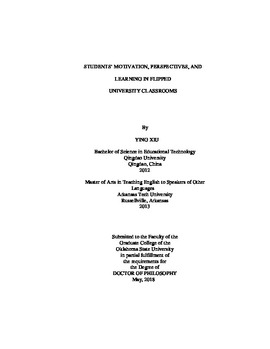| dc.contributor.advisor | Thompson, Penny | |
| dc.contributor.author | Xiu, Ying | |
| dc.date.accessioned | 2019-03-25T21:13:39Z | |
| dc.date.available | 2019-03-25T21:13:39Z | |
| dc.date.issued | 2018-05 | |
| dc.identifier.uri | https://hdl.handle.net/11244/317721 | |
| dc.description.abstract | The flipped classroom, introduced by Jonathan Bergmann and Aaron Sams in 2008, has been a popular instructional strategy that promotes active learning. In a flipped classroom, the learning content is provided to students before class, and class time is dedicated to engaging students in student-centered activities that reinforce and integrate the knowledge. This dissertation aims to explore the relationship between motivation and students' perspectives, learning performance, and use of online course materials in flipped classrooms. Fifty-nine undergraduate students enrolled in flipped classes completed a survey soliciting their motivation, as defined by the Expectancy-Value theory, and their perceptions of the flipped course. Students' expectancy beliefs (control beliefs about learning, self-efficacy) and value beliefs (task value, intrinsic motivation, extrinsic motivation) were measured by subscales adopted from Motivated Strategies for Learning Questionnaire (MSLQ). Students' final grade percentage represented their learning performance. Brightspace log data were obtained to evaluate students' use of online materials. Results indicated that motivation had an effect on students learning in flipped classroom environments. Students have similar motivation patterns regarding their learning performance in flipped classrooms as in traditional or online classrooms. Regression analyses indicated self-efficacy is a significant predictor of both students' academic achievement and perceptions of the flipped classroom. Overall, students had positive attitudes towards the flipped model but indicated neutral attitudes when asked if they wished more instructors used the flipped classroom model. This study adds to the literature for understanding students' motivation in flipped educational settings and suggests implications for effective teaching in a flipped classroom. Although the flipped classroom may change the teacher's role from "sage on the stage" to a "guide on the side," (King, 1993) the teacher's role in the learning environment remains vitally important. | |
| dc.format | application/pdf | |
| dc.language | en_US | |
| dc.rights | Copyright is held by the author who has granted the Oklahoma State University Library the non-exclusive right to share this material in its institutional repository. Contact Digital Library Services at lib-dls@okstate.edu or 405-744-9161 for the permission policy on the use, reproduction or distribution of this material. | |
| dc.title | Students' motivation, perspectives, and learning in flipped university classrooms | |
| dc.contributor.committeeMember | Stansberry, Susan L. | |
| dc.contributor.committeeMember | Asino, Tutaleni I. | |
| dc.contributor.committeeMember | Vogler, Jane S. | |
| osu.filename | Xiu_okstate_0664D_15621.pdf | |
| osu.accesstype | Open Access | |
| dc.type.genre | Dissertation | |
| dc.type.material | Text | |
| thesis.degree.discipline | Educational Technology | |
| thesis.degree.grantor | Oklahoma State University | |
